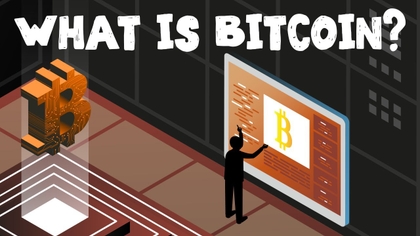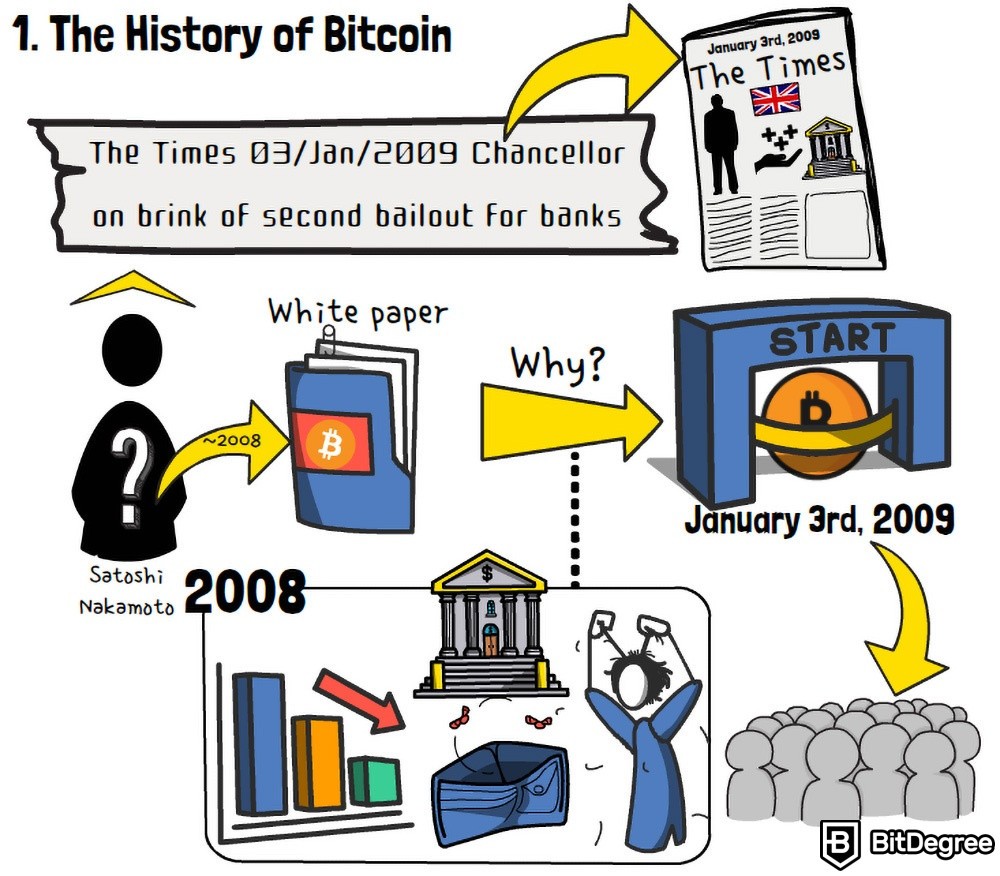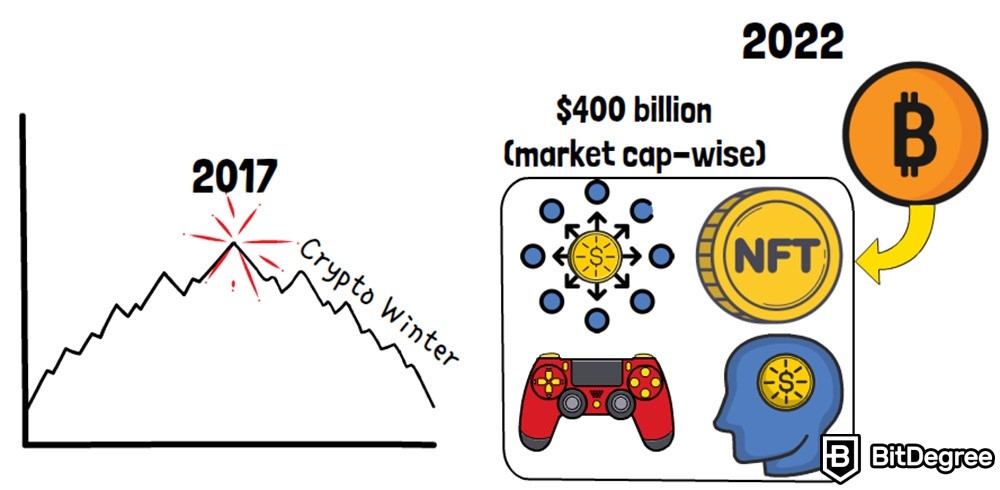2.6 Bitcoin: the Pioneer of the Crypto World
Stop overpaying - start transferring money with Ogvio. Join the waitlist & grab early Rewards NOW! 🎁
In this section, I’m going to answer the question what is a Bitcoin, as well as look into how does it work!
Cryptocurrencies have exploded in popularity, over the last decade or so. These days, everyone, and even their pets, have seemingly heard about crypto, DeFi, NFTs, and so on. As time goes on, however, the popularity of the space is only growing and increasing - there are more and more talks about mass adoption, and the integration of crypto into our everyday lives!
Do you know where it all started, though? Well, most people do - with Bitcoin. However, what do you *really* know about Bitcoin? I mean, do you know who owns the most Bitcoin, or when was Bitcoin created, in the first place? Those are just a couple of the questions that you'll find answers to after reading this section!
So, in this section, we’re going to look into what is a Bitcoin. Specifically, I’ll tell you about the history of this legendary cryptocurrency, what makes it special, and how it became a staple for a trillion-dollar industry!
Without further ado, let’s get to it!

Video Explainer
Video Explainer: Bitcoin: the Pioneer of the Crypto World
Reading is not your thing? Watch the "Bitcoin: the Pioneer of the Crypto World" video explainer
What is a Bitcoin & How Does it work? (Animated Explainer)


The History of Bitcoin
In order to start figuring out what is Bitcoin and how does it work, we need to go back in time, to 2009. This is the year when Bitcoin was created, and launched to the general public.
Before Bitcoin came to be, however, there was first something called a “Whitepaper”. This is a term that describes a document containing all of the philosophy behind a specific crypto project - these days, most-all decentralized finance platforms and tokens have Whitepapers written about them, and Bitcoin was no exception, either.

How is this Whitepaper so important, you might ask? Well, it can tell us a lot about two big topics - who started (or, created) Bitcoin, and what’s the purpose of this project, in the first place.
If you love internet mysteries, you’ve probably heard the name “Satoshi Nakamoto” before. This is actually a pseudonym of the creator of Bitcoin, and not their real name - truth be told, to this very day, NO ONE KNOWS who created Bitcoin! Even after all these years, the creator (or creators?) has remained anonymous. For simplicity’s sake, I’ll be referring to Satoshi as a “he” - it could, however, be a woman, a group of people, or an entire organization!
You'll find more information about Satoshi below, so, for now, let’s focus on the second question - WHY was Bitcoin created? Well, the answer might lie in the date of its creation.
2009 wasn’t really a special year, globally speaking. However, Bitcoin was launched on January 3rd, 2009 - so, at the very beginning of the year. What this means is that the actual project was created a year prior. And, I have a feeling that I don’t even really need to tell you what happened in 2008.
That’s right - the global financial crisis. In a very specific sense, Bitcoin was the result of this crisis.
When a cryptocurrency is created, the very first block of its blockchain is called “the Genesis block”. If you’d like to learn more about blockchains and how they work, there are a few dedicated sections concerning the topic in our Crypto 101 Handbook - make sure to check them out! Focusing on what is Bitcoin and how does it work, however, all that you need to know for now is that the creators of a cryptocurrency - such as Bitcoin - can leave a human-readable message within that Genesis block. Satoshi Nakamoto did just that - his message read:
The Times 03/Jan/2009 Chancellor on brink of second bailout for banks.
It’s a reference to an article title of The Times newspaper, from the day when BTC was launched. As you might be able to tell, the title talks about the Chancellor of the United Kingdom bailing out banks, after the global financial crisis - since it’s widely accepted that banking institutions were a major element of the crisis, in the first place, you can probably see where this is going.

To circle back to the questions of what is Bitcoin used for, and why it was created, the answer seems to be pretty simple - to take some economic power away from banks and governmental institutions, and hand it back to your common, everyday people. Bitcoin was initially meant to be a form of digital money that is both completely private, as well as transparent, and not belonging to any one entity - in other words, 100% decentralized.
It is widely accepted that, whoever Satoshi Nakamoto was, he was very concerned with the state of the global economy, and how huge financial institutions could weasel their way out of a major financial crisis that they’ve caused, shifting all of the economic burdens that came with it onto the masses of innocent people. Bitcoin was the answer to this - a way for those masses of people to, for the first time, truly own their own money, and not have it tied to the state or government.
Of course, when talking about these things, you could also question what is Bitcoin backed by, or how it tackles problems such as inflation and regulations. These are topics for other sections, though - in this section, our goal is to look at the basics of what is Bitcoin, and how it became the global phenomenon it is today.
Going back to the creation of Bitcoin, after it was launched, Satoshi Nakamoto would still show up in various forums online. He was an avid fan of cryptography, and would constantly hang out in related online forums and discussion boards, talking with other like-minded individuals, and trying to come up with what would eventually become Bitcoin. In fact, Bitcoin wasn’t even the first attempt at creating a form of digital currency - it was simply the attempt that was successful.
Pretty soon, however, Satoshi disappeared - today, not only does no one know who he is, it’s impossible to say whether or not he’s still alive, or active among crypto circles around the world. I mean, who knows - perhaps he’s a very active member of the Bitcoin community, but no one could ever tell?
Going back to the launch of BTC, you might ask - how much was Bitcoin in 2009? Well, the truth is - fractions of a penny! BTC only started gaining price traction around 2011, two years after its inception. Even then, you could purchase multiple Bitcoins with a single $1.

You’ve probably heard about the legendary story of a guy who purchased two Papa John’s pizzas for 10,000 Bitcoin, back in 2010. While it was quirky and cool, it was also a very significant moment for Bitcoin, this being one of the very first major events where BTC was used to purchase actual, tangible real-world items. This event has become so notable, that there’s now even a Bitcoin Pizza day being held, every year.
That’s no wonder, really - today, those pizzas would be worth over $200 million. It’s absolutely incredible to think about!
Hearing all of these numbers being thrown around, you might also ponder - who owns the most Bitcoin? Well, there are actually two notable parties that need to be mentioned here.

As far as the public is concerned, a US-based software company called Microstrategy is the largest BTC whale, holding nearly 130k BTC. When you learn about what is a Bitcoin, this number really does appear to be mind-boggling!
However, there’s another answer, too. It’s widely speculated that none other than Satoshi Nakamoto himself is the largest holder of BTC - if the calculations are true, Satoshi still holds over 1,1 million Bitcoin, spread throughout his wallets.
Going back to the history of Bitcoin, and skipping through some minor events, the popularity - and, consequently, price - of BTC grew over the years. The first major crypto boom happened in 2017, and was followed by what we now call the Crypto Winter - a sudden price crash, and then a few years of stagnation.

Today, Bitcoin alone is worth nearly $400 billion (market cap-wise), and that's not to mention the rest of the cryptocurrency industry. BTC paved the way for decentralized finance, NFTs, crypto gaming, and a new form of finance, as a whole - the importance of all of these things can’t be understated!
The Future of Bitcoin
Now that we’ve covered the general history and background of Bitcoin, we should also talk about the potential future of this cryptocurrency. In order to do that, though, we need to go back to the question of how does Bitcoin work, to begin with.
As mentioned before, BTC is completely decentralized and anonymity-preserving. Meaning, the cryptocurrency can be traded between two parties, and while all trades will be public and visible on the blockchain, the actual participants will remain anonymous.
This is done with the help of Bitcoin wallets. If you’re wondering what is a Bitcoin address, well, that’s just it - the term references a wallet address. It’s like a special string of numbers and letters, used to identify you on the blockchain. When you perform trades, or send BTC to your friends, only your wallet addresses will be visible - unless you tell the whole world that THIS wallet address belongs to YOU, no one will know! Well, generally speaking, that is.

Naturally, decentralization is another key factor. Bitcoin doesn’t belong to any single private or governmental entity. This means that there’s no single point of failure, either - in theory, this results in a fairer, more transparent financial system.
If you’d like to learn more about the specifics of decentralization and anonymity, there's a section covering both of these topics - check it out!
Having said all of that, and now that you know what is Bitcoin, how does it work, and what it’s used for, what’s next for this cryptocurrency - in other words, what is Bitcoin’s future?
Well, as you might expect, no one knows for sure! However, if we were to take a look at the history of Bitcoin, it seems that this cryptocurrency isn’t going anywhere.
Throughout the years, thousands of new crypto projects have emerged and grown to become notable names in the industry. During all this time, though, Bitcoin has always remained the No. 1 crypto asset, market-wise, as well as in many people’s minds, too. There’s even a term for that - it’s called “Bitcoin maximalism”.
As time goes on, Bitcoin is also getting progressively more difficult to mine. Combine that with the fact that this crypto asset has a hard cap of 21 million (that’s the total number of Bitcoin that will ever exist), and you have an asset that’s becoming more and more scarce, yet seemingly also increasingly more sought-after, as well.
Whatever challenges Bitcoin might face in the future, one thing’s for sure - if not for this cryptocurrency, I wouldn’t be writing this, and you wouldn’t be reading it. Chances are that there wouldn’t be any DeFi or other cryptos, either, at least not in the form that we know them now! With this industry constantly growing and reaching new milestones, many enthusiasts believe that this is just the beginning of a long and adventure-filled journey.










